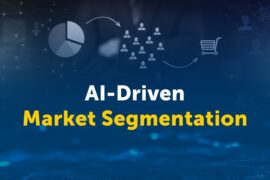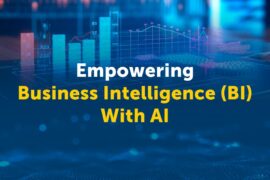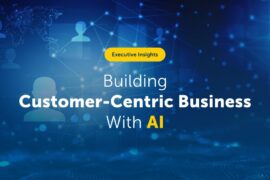AI is set to begin a new era of healthcare advancements in 2024 and beyond. As an industry leader, you are familiar with the ongoing impact of artificial intelligence (AI) on healthcare delivery. Be it personalized treatment plans or early disease detection, these breakthroughs for healthcare providers are underway.
The transformative journey of AI for healthcare delivery is not without its complexities. Ethical concerns, potential biases embedded in algorithms, and the responsible use of AI underscore the need for careful navigation. The delicate balance lies in leveraging AI’s potential for innovation while acknowledging its limitations, ensuring a conscientious integration that steers towards a future where the benefits of AI are accessible to all.
The prevailing theme is one of progress and opportunity for AI Healthcare. Decision makers and healthcare leaders have a chance to leverage AI for better patient outcomes, cost reduction, and improved patient experience. The moment has arrived to embrace AI’s potential and steer healthcare towards a transformative future.
Predictions for Advancements in AI in Healthcare Delivery
Early Disease Detection and Diagnosis With AI
AI systems can analyze huge amounts of data to detect patterns that humans may miss, enabling earlier disease detection and diagnosis. AI algorithms can monitor patient data from multiple sources, including electronic health records, medical scans, genomics, and wearable devices to detect anomalies that could indicate disease.
For example, AI can analyze speech patterns to detect signs of cognitive decline or review retinal scans to detect diabetic retinopathy. AI also shows promise for detecting various cancers, Alzheimer’s, heart disease, and other conditions earlier by finding subtle patterns across large datasets. Earlier detection of diseases through AI surveillance and diagnosis can allow for earlier treatment, often leading to better outcomes.
Some companies are developing AI diagnostics tools for physicians to use in practice, while others are creating direct-to-consumer products. With proper oversight and safeguards in place, AI-enabled diagnostics may become a standard part of healthcare delivery in the coming years.
Click here to explore the how Fusemachines transforms healthcare businesses with its expert AI solutions. To schedule a complimentary consultation today, click here.
Telemedicine, Remote Monitoring and NLP for Patient Records
Telemedicine and remote monitoring have enabled healthcare delivery professionals to provide care from a distance using telecommunications technology. Patients can connect with doctors via phone or video for diagnosis, treatment, and monitoring. Physicians can also continuously monitor patients’ vital signs and health data remotely.
Natural language processing (NLP) allows clinicians to analyze unstructured data in electronic health records (EHRs) and patient notes to gain insights. NLP can identify relationships and patterns in large amounts of text to help predict health risks, determine diagnoses, and suggest personalized treatment plans. Extracting information from EHRs and transforming it into structured data supports predictive analytics and personalized care.
The integration of telemedicine, remote monitoring, and NLP will transform healthcare delivery. Patients will have more convenient access to care and monitoring. Clinicians can gain a holistic view of a patient’s health and provide customized treatment. Healthcare organizations will operate more efficiently using data-driven insights to anticipate needs, reduce costs, and improve outcomes.
Click here to explore the how Fusemachines transforms healthcare businesses with its expert AI solutions. To schedule a complimentary consultation today, click here.
Personalized Treatment Plans
Personalized treatment plans tailored to each patient’s unique genetic profile and health conditions will transform healthcare delivery. Physicians will utilize AI and machine learning to analyze a patient’s genetic markers, medical history, and lifestyle to create customized diagnoses and treatment plans.
Genetic Mapping
Mapping a patient’s genome can reveal predispositions for certain diseases and the most effective treatment options based on their genetic makeup. AI will help doctors interpret complex genomic data to determine the appropriate course of action for each patient.
Lifestyle Tracking
Wearable devices and mobile apps will provide doctors with data on a patient’s activity levels, sleep, nutrition, and other health metrics to gain a more holistic view of their wellbeing. AI can then suggest lifestyle or behavior changes to help patients stay healthy or better manage chronic illnesses.
Continuous Monitoring
AI-enabled wearable sensors and in-home diagnostic tools continuously track patients’ vital signs, biomarkers, and health conditions. Doctors receive real-time updates on patients’ health and be alerted to signs of deterioration or complications so they can intervene quickly. Continuous monitoring will enable truly personalized care tailored to each patient’s needs.
Treatment Optimization
AI can analyze how patients respond to treatments to determine what works best based on their genetics, health conditions, and biomarkers. Doctors will get data-driven insights into optimal courses of treatment and medication dosages for each patient. AI may also suggest alternative options if treatment is not working as intended. Personalized care will become increasingly precise and effective.
Robotic Assistance in Surgery
Robotic surgery assistance is poised to expand in hospitals over the next few years. Surgeons currently utilize robotic surgical systems to perform minimally invasive procedures with greater precision, flexibility, and control. As AI and robotics continue to advance, surgical robots will become more autonomous and collaborative.
Increased Autonomy
Robotic surgical systems will handle more procedural tasks on their own, such as suturing, freeing surgeons to focus on the most complex and critical parts of an operation. Robots with enhanced visual capabilities and haptic feedback systems will provide surgeons immersive control and the ability to feel the forces on surgical instruments.
Collaboration and Cooperation
Teams of surgeons will be able to collaborate through connected robotic systems to perform complex surgeries. Multiple surgeons can jointly control robotic arms or pass control back and forth seamlessly during a procedure. Remote presence technology will allow expert surgeons to guide less experienced surgeons through a robotic operation from a distance.
Continuous Learning
AI-powered robotic surgical systems will continuously learn from every procedure to expand their knowledge and skills. As they observe more surgeries, they will suggest and may even perform approved procedural steps to assist surgeons. Human surgeons will remain fully in control of AI-guided robots and be able to override their recommendations at any point.
Predictive Analytics for Hospital Operations
Predictive analytics leverages historical data to identify patterns and make predictions about future events. Hospitals can apply predictive analytics to optimize operations and resource allocation.
Forecasting Patient Volume
Hospitals can predict daily patient volume by analyzing historical emergency room and clinic visit data. This allows administrators to properly staff departments and have the necessary supplies on hand. Predicting admission rates also helps with resource planning and managing patient flow.
Optimizing Staff Scheduling
Predictive scheduling uses analytics to determine optimal staffing levels based on predicted patient volume and acuity. This ensures there are enough nurses, doctors, and support staff to provide high-quality care without overstaffing. It can reduce costs through improved productivity and staff satisfaction.
Managing Equipment and Supplies
Predictive analytics also helps ensure hospitals have the essential equipment, devices, medication, and other supplies when needed. Hospitals can accurately anticipate necessary inventory levels by forecasting the types of procedures, surgeries, and treatments required. This minimizes the risk of running out of critical items or overstocking supplies.
Improving Outcomes
Some predictive models can determine the likelihood of adverse events such as falls, hospital-acquired infections, or readmissions. By identifying high-risk patients, staff can provide targeted interventions to improve outcomes. Predictive analytics may also help determine the most effective treatment plans based on a patient’s unique characteristics and medical history.
Medical Documentation Automation with AI
In the dynamic landscape of healthcare, the integration of AI has transcended the role of mere assistance, showcasing its ability to work independently in specific scenarios. One compelling use case revolves around the realm of medical documentation transfer and management. In a large healthcare institution, the challenge of streamlining routine documentation can be solved by implementing an AI-driven solution.
An AI-powered intelligent system, equipped with generative AI and natural language processing capabilities, autonomously handles the transfer of information from handwritten notes to digital records, organizes electronic health records (EHRs), and even generates preliminary reports for routine cases. The tangible outcome is a paradigm shift in workflow dynamics—AI is not just assisting but working independently to enhance efficiency, reduce errors, and optimize the allocation of human resources. This use case exemplifies how AI’s autonomy in routine tasks empowers healthcare delivery professionals to dedicate more time to the nuanced aspects of patient care and complex decision-making.
Click here to explore the how Fusemachines transforms healthcare businesses with its expert AI solutions. To schedule a complimentary consultation today, click here.
Generative AI-Powered Tools for Mental Health Care
Mental health apps are undergoing a transformative shift, becoming more interactive and user-friendly through the integration of generative AI. These advanced technologies, including mental health chatbots and virtual agents, act as empathetic first responders, offering nuanced suggestions for those seeking assistance.
Generative AI models, at the forefront of speech, text, and behavior analysis, are key players in this transformation. In speech analysis, these models discern emotional nuances, identifying potential signs of conditions like PTSD or depression. The dynamic response generation of generative AI enhances context-aware interactions, providing more personalized and effective support.
Mobile applications leveraging generative AI analyze user behavior, including typing and swiping patterns, to detect early signs of mental health conditions. By proactively identifying symptoms, these tools facilitate timely interventions, enabling individuals to connect with mental health professionals when needed. The synergy between generative AI and mental health tools represents a pivotal step toward accessible, preventive, and personalized mental health support.
The Importance of Continued Learning and Collaboration
For AI in healthcare to achieve its full potential, researchers and professionals in both fields must work together. Continual progress requires ongoing collaboration between data scientists, physicians, and other healthcare experts.
Cross-disciplinary teams should focus on identifying and addressing challenges, refining AI systems, and responsibly implementing new technologies. Feedback loops enabling the exchange of insights among researchers and practitioners in each domain will facilitate progress.
Both human and AI agents have a role to play in improving healthcare delivery. Professionals can provide contextual knowledge, ask critical questions, and ensure solutions align with ethical values. AI systems can help scale insights, enhance pattern detection, and optimize resource allocation. However, human judgment and oversight remain essential.
Through shared dedication to continued learning and partnership, researchers and physicians alike can shape the responsible development of AI in healthcare. Progress will depend on openness to gaining new perspectives, willingness to reconsider assumptions, and commitment to serving human needs.
Bottom Line
AI will transform healthcare in exciting and meaningful ways. The advancements in personalized treatment, early disease detection, drug development, and telemedicine offer promising solutions to improve patient outcomes, reduce costs, and make high-quality care more accessible.
In recognizing AI as a formidable force in healthcare, it’s essential to acknowledge its current role as a valuable assisting agent rather than a flawless independent solution. While not perfect, AI is on an evolutionary trajectory, steadily improving in accuracy and reliability. As technology advances, healthcare businesses that embrace early adoption stand to benefit significantly from the increasing confidence and autonomy of AI solutions. This ongoing refinement positions AI as a pivotal tool for precision, efficiency, and innovative possibilities, promising a transformative impact on patient care and operational efficiency.
Healthcare organizations must thoughtfully navigate the ethical and regulatory challenges that come with these emerging technologies. By incorporating AI into the strategic vision, investing in tools and talent, and fostering a culture of continuous learning and collaboration, healthcare leaders can harness the power of AI to build a healthier future for us all.
Click here to explore the how Fusemachines transforms healthcare businesses with its expert AI solutions. To schedule a complimentary consultation today, click here.







